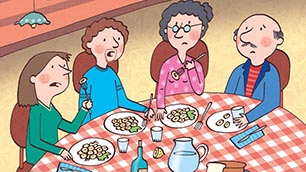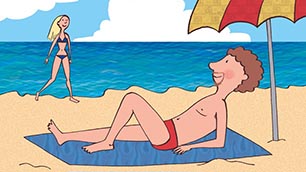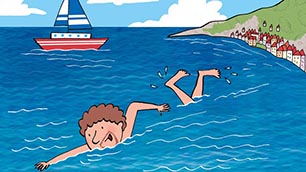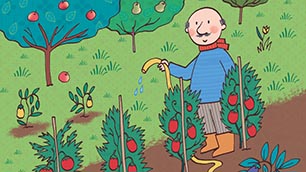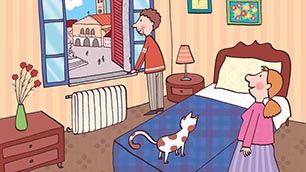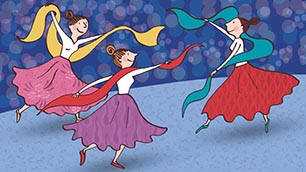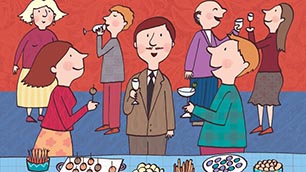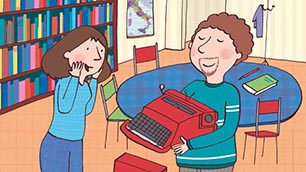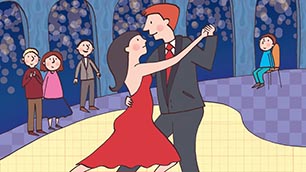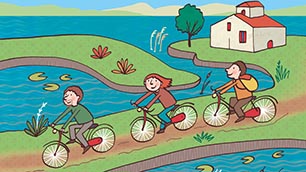Nouns
In Italian, unlike in English, all nouns have a gender. For some nouns, the gender is quite obvious. For example, words like donna, madre and sorella are feminine, and words like uomo, padre and fratello are masculine. For all other nouns, it is necessary to learn the correct gender. This really isn’t as difficult as it might sound, though.
As a general rule, nouns ending in -o are masculine, and nouns ending in -a are feminine. Nouns ending in -e can either be masculine or feminine. There is no rule determining the gender of many nouns ending in -e, but there are a few helpful guidelines.
- Nouns ending in -ore are masculine.
autore ... author fiore ... flower colore ... color - Nouns ending in -trice and -zione are feminine.
autrice ... (female) author pittrice … (female) painter azione ... action colazione … breakfast
| ragazzo (boy) ... ragazzi (boys) |
| ragazza (girl) ... ragazze (girls) |
| maestro (teacher [male]) ... maestri (teachers) |
| maestra (teacher [female]) ... maestre (teachers) |
| fiore (flower) ... fiori (flowers) |
| autrice (author [female]) ... autrici (authors) |
Adjectives
Just like nouns in Italian, adjectives also have a gender and number. An adjective’s gender and number depend on the noun it is describing. Most Italian adjectives end in -o and have four forms: masculine singular, masculine plural, feminine singular, and feminine plural. Following are examples of each. Please observe how adjectives and nouns must agree with each other in gender and number.
| Masculine singular: | il treno nuovo ... the new train | |
| Feminine singular: | la casa nuova ... the new house | |
| Masculine plural: | i treni nuovi ... the new trains | |
| Feminine plural: | le case nuove ... the new houses |
Present Indicative of the Verb stare
The verb stare literally means to stay, but it is used in many common phrases where we would use the verb to be in English. See the following examples:
| Come stai? | How are you? (informal) | |
| Sto bene, grazie. | I’m fine, thank you. | |
| Come sta il bimbo? | How is the baby? | |
| Non sta molto bene. | He isn’t doing very well. |
You can see the verb stare conjugated in the present indicative in the following table.
| io sto | noi stiamo | |
| tu stai | voi state | |
| lui/lei/Lei sta | loro stanno |
Formal and Informal: Lei and tu
In Italian, there are four ways to express the English you. If you address a friend, relative, child, peer, or anyone with whom you have a certain familiarity, you use the pronoun tu. The plural of tu is voi, and it is used when you address two or more people whom you know. (Voi was once used as a way of formally addressing one person, and it is still used in this manner in some places, primarily in Southern Italy.) When you address a stranger, a person of authority, or an older person, you use Lei. Lei is the formal singular and it is generally capitalized. The plural of Lei is Loro, and it is also frequently capitalized. However, in contemporary Italy Loro is seldom used, and most Italians will use voi when addressing a group of two or more people, regardless of their status. Following are some examples of formal and informal exchanges.
| Ciao Carla! Come stai? | Hi Carla! How are you? (informal) | |
| Salve professore. Come sta? | Hello professor. How are you? (formal) | |
| Buongiorno Roberto! Stai bene? | Good morning Roberto! Are you well? (informal) | |
| Buongiorno Signore. Lei sta bene? | Good morning sir. Are you well? (formal) | |
| Scusi, Lei come si chiama? | Excuse me, what is your name? (formal) |
Forming Questions in Italian
In Italian, a statement can be changed into a question by simply placing a question mark at its end. In spoken language, this is conveyed with intonation.| Patrizia è studentessa. | Patrizia is a student. | |
| Patrizia è studentessa? | Is Patrizia a student? |
There are a number of interrogative words used to introduce questions, some of which we have already begun to see. The most common ones are as follows:
| come ... how |
| dove ... where |
| quale ... which |
| chi ... who |
| perché ... why |
| quanto ... how much |
| quando ... when |
Examples:
| Come stai? | How are you? | |
| Come ti chiami? | What is your name? (Literally: How are you called?) | |
| Chi sei? | Who are you? | |
| Quant’è? | How much is it? | |
| Quando siete in Italia? | When are you in Italy? | |
| Di dove sei? | Where are you from? | |
| Quale fiore? | Which flower? |







